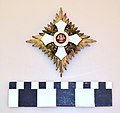You can help expand this article with text translated from the corresponding article in German. (January 2019)Click [show] for important translation instructions.
|
| Royal Order of Civil Merit Орден „За гражданска заслуга“ | |
|---|---|
 Grand Cross set of the Order (1946) | |
| Awarded by | |
| Type | Dynastic Order |
| Royal house | House of Saxe-Coburg-Gotha-Koháry |
| Religious affiliation | Bulgarian Orthodox |
| Ribbon | White with a Green Stripe on either side and a Red Stripe on either Edge (Colours of the Flag of Bulgaria) |
| Eligibility | Bulgarian and foreign citizens |
| Awarded for | Awarded with the personal benevolence of the monarch |
| Status | Unconstituted |
| Grand Master [1] | King Simeon II |
| Grades | Knight/Dame Grand Cross Knight/Dame Grand Officer Knight/Dame Commander Knight/Dame Officer Knight/Dame Medal |
| Precedence | |
| Next (higher) | Royal Order of Bravery |
| Next (lower) | Royal Order of National Labour |
| Equivalent | Royal Order of Military Merit |
| The ribbon of the Order | |
The Order of Civil Merit was an Order of Merit of the Kingdom of Bulgaria. Established in 1891, it had six classes.

























